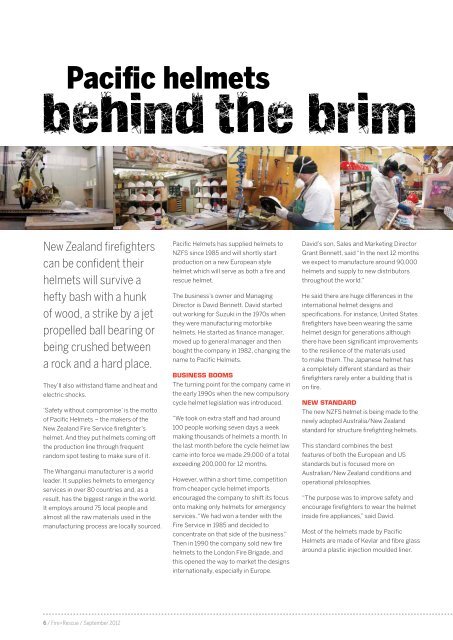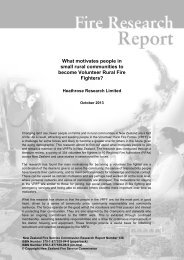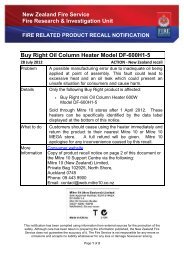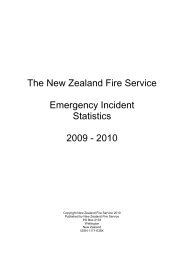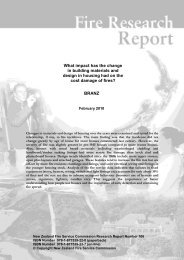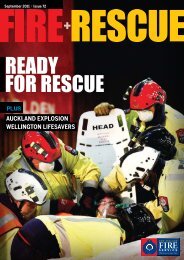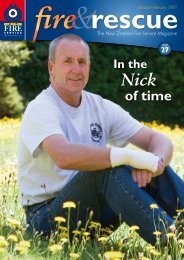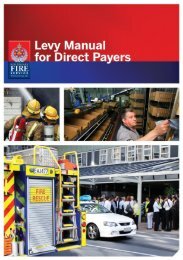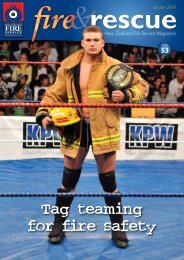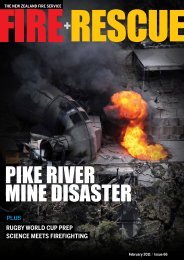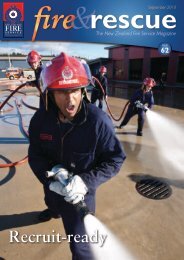Download PDF: Issue 83 - New Zealand Fire Service
Download PDF: Issue 83 - New Zealand Fire Service
Download PDF: Issue 83 - New Zealand Fire Service
You also want an ePaper? Increase the reach of your titles
YUMPU automatically turns print PDFs into web optimized ePapers that Google loves.
Pacific helmets<br />
behind the brim<br />
<strong>New</strong> <strong>Zealand</strong> firefighters<br />
can be confident their<br />
helmets will survive a<br />
hefty bash with a hunk<br />
of wood, a strike by a jet<br />
propelled ball bearing or<br />
being crushed between<br />
a rock and a hard place.<br />
They’ll also withstand flame and heat and<br />
electric shocks.<br />
‘Safety without compromise’ is the motto<br />
of Pacific Helmets – the makers of the<br />
<strong>New</strong> <strong>Zealand</strong> <strong>Fire</strong> <strong>Service</strong> firefighter’s<br />
helmet. And they put helmets coming off<br />
the production line through frequent<br />
random spot testing to make sure of it.<br />
The Whanganui manufacturer is a world<br />
leader. It supplies helmets to emergency<br />
services in over 80 countries and, as a<br />
result, has the biggest range in the world.<br />
It employs around 75 local people and<br />
almost all the raw materials used in the<br />
manufacturing process are locally sourced.<br />
6 / <strong>Fire</strong>+Rescue / September 2012<br />
Pacific Helmets has supplied helmets to<br />
NZFS since 1985 and will shortly start<br />
production on a new European style<br />
helmet which will serve as both a fire and<br />
rescue helmet.<br />
The business’s owner and Managing<br />
Director is David Bennett. David started<br />
out working for Suzuki in the 1970s when<br />
they were manufacturing motorbike<br />
helmets. He started as finance manager,<br />
moved up to general manager and then<br />
bought the company in 1982, changing the<br />
name to Pacific Helmets.<br />
Business Booms<br />
The turning point for the company came in<br />
the early 1990s when the new compulsory<br />
cycle helmet legislation was introduced.<br />
“We took on extra staff and had around<br />
100 people working seven days a week<br />
making thousands of helmets a month. In<br />
the last month before the cycle helmet law<br />
came into force we made 29,000 of a total<br />
exceeding 200,000 for 12 months.<br />
However, within a short time, competition<br />
from cheaper cycle helmet imports<br />
encouraged the company to shift its focus<br />
onto making only helmets for emergency<br />
services. “We had won a tender with the<br />
<strong>Fire</strong> <strong>Service</strong> in 1985 and decided to<br />
concentrate on that side of the business.”<br />
Then in 1990 the company sold new fire<br />
helmets to the London <strong>Fire</strong> Brigade, and<br />
this opened the way to market the designs<br />
internationally, especially in Europe.<br />
David’s son, Sales and Marketing Director<br />
Grant Bennett, said “In the next 12 months<br />
we expect to manufacture around 90,000<br />
helmets and supply to new distributors<br />
throughout the world.”<br />
He said there are huge differences in the<br />
international helmet designs and<br />
specifications. For instance, United States<br />
firefighters have been wearing the same<br />
helmet design for generations although<br />
there have been significant improvements<br />
to the resilience of the materials used<br />
to make them. The Japanese helmet has<br />
a completely different standard as their<br />
firefighters rarely enter a building that is<br />
on fire.<br />
new standard<br />
The new NZFS helmet is being made to the<br />
newly adopted Australia/<strong>New</strong> <strong>Zealand</strong><br />
standard for structure firefighting helmets.<br />
This standard combines the best<br />
features of both the European and US<br />
standards but is focused more on<br />
Australian/<strong>New</strong> <strong>Zealand</strong> conditions and<br />
operational philosophies.<br />
“The purpose was to improve safety and<br />
encourage firefighters to wear the helmet<br />
inside fire appliances,” said David.<br />
Most of the helmets made by Pacific<br />
Helmets are made of Kevlar and fibre glass<br />
around a plastic injection moulded liner.


